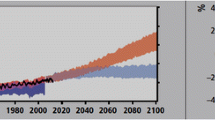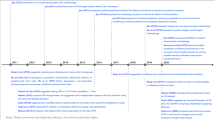Abstract
In this study, Saudi Arabia is divided into five geographical regions: northwestern, southwestern, western, central, and finally, eastern with central. The study shows the possibility of constructing and formatting rainfall as a regional variable depending on the locality. Two techniques derived from the point cumulative semivariogram (PCSV) model are used to predict rainfall in the five regions. These are, namely, the trigonometric point cumulative semivariogram (TPCSV) method and the classical weighing average method (classical point cumulative semivariogram (CPCSV)). These methods are applied to data from 21 weather stations in the five regions for a 35-year period from 1970 to 2005 in the majority of stations. It is found that the absolute error between observed values and the predicted values using TPCSV and CPCSV does not exceed 5 and 13 %, respectively, except in the central region, where the absolute error is 18 % using both methods. Regarding the spatial rainfall variation in the region, the strength of correlation is calculated in terms of angles among the sites using the TPCSV technique, the smaller the angle the stronger the correlation. The standard weighing function (SWF) is used to find the weight of rainfall records at each site, which expresses the effect of locality on rainfall variation. The SWF approach reflects the homogeneity of rainfall around the pivot sites in all regions except the central. High-correlation angles (85, 90, and 88°) among the sites of the region explain the weakness of correlation among this set of station, where the error of prediction both method in this region exceeds 18 %. PCSV succeeds in explaining the spatial rainfall variation and finding the weight of rainfall phenomena for each site in all five regions, while successfully predicting rainfall.









Similar content being viewed by others
References
Abdullah MA, Al-Mazroui M (1998) Climatological study of the southwestern region of Saudi Arabia. I. Rainfall analysis. Clim Res 9:213–223
Al-Khashman OA, Tarawneh QY (2007) Spatial prediction model and its application to chemistry of atmospheric precipitation in. Jordan Atmos Res 84(4):399–409
Almazroui M (2010) Calibration of TRMM rainfall climatology over Saudi Arabia during 1998–2009. Atmos Res. doi:10.1016/j.atmosres.2010.11.006
Barnes SL (1964) A technique for maximizing details in numerical weather map analysis. J Appl Meteorol 3:396–409
Bayraktar H, Turalioglu FS, Şen Z (2005) The estimation of average areal precipitation by percentage weighting polygon method in Southeastern Anatolia Region, Turkey. Atmos Res 73:149–160
Bras RL, Rodriguez-Itrube L (1985) Random function in hydrology. Addison-Wesley Publishing, Reading, p 5995
Christakos G (1998) Spatiotemporal information systems in soil and environmental sciences. Geoderma 85:141–179
Cressman GP (1959) An operation objective analysis system. Mon Rev 87(10):367–374
Dixson R (1969) Orthogonal polynomials as a basis analysis. H. M. S. O, London
Haas TC (2002) New systems for modeling, estimating, and predicting a multivariate spatio-temporal process. Environmetrics 13:311–332
Kalman RE (1960) A new approach to linear filtering and prediction problems. J Basic Eng 82(series D):34–45
Kyriakidis PC, Journel AG (1999) Geostatistical space–time models: a review. Math Geol 31:651–684
Liu X, Yin ZY (2001) Spatial and temporal variation of summer precipitation over the Eastern Tibetan Plateau and the North Atlantic Oscillation. J Clim 14(13):2896–2909
Mark N, Todd M, Hulme M, Jones P (2001) Precipitation measurements and trends in the twentieth century. Int J Climatol 21(15):1899–1922
Matheron G (1963) Principles of geostatistics: economic geology. 58:1246–1266
Panofsky HA, Barier GW (1958) Some application of statistics to meteorology. Pennsylvania State University Press, Pennsylvania
Şahin AD, Şen Z (2004) A new spatial prediction model and its application to wind records. Theor Appl Climatol 79:45–54
Sasaki Y (1960) An objective analysis for determining initial conditions for the primitive equations. Tech. Rep., (Ref. 60–16T). Atmospheric Reseach Lab., University of Okloma, Res. Institute, Norman
Şen Z (1980a) Adaptive fourier-analysis of periodic-stochastic hydrologic sequences. J Hydrol 46(3–4):239–249
Şen Z (1980b) Regional drought and flood frequency-analysis-theoretical consideration. J Hydrol 46(3–4):265–279
Şen Z (1989) Cumulative semivariogram model of regionalized variable. Math Geol 21:891–903
Şen Z (1995) Regional air pollution assessment by cumulative semivariogram techniques. Atmos Environ 29(4):543–548
Şen Z (1997) Objective analysis by cumulative semivariogram technique and its application in Turkey. J Appl Meteorol 36(12):1712–1724
Şen Z (1998) Average areal precipitation by percentage weighting polygon method. J Hydrol Eng 1:69–72
Şen Z, Al-Suba’i K (2001) Seismic hazard assessment in the Tihamat Asir region, southwestern Saudi Arabia. Math Geol 33(8):967–991
Şen Z, Habib Z (1998) Point cumulative semivariogram of areal precipitation in mountainous regions. J Hydrol 205:81–91
Şen Z, Habib Z (2000) Spatial precipitation assessment with elevation by using Point Cumulative Semivariogram Technique. Water Resour Manag 14:311–325
Şen Z, Öztopal A (2001) Assessment of regional air pollution variabilityin Istanbul. Environmetrics 12:401–420
Şen Z, Şahin AD (1998) Regional wind energy evaluation in some parts of Turkey. J Wind Eng Ind Aerodyn 74–76:345–353
Şen Z, Şahin AD (2001) Spatial interpolation and estimation of solar irradiatiation by cumulative semivariograms. Sol Energy 71:11–21
Shehadeh N (1991) The climate of Jordan. Al-basheer Press, Amman
Sinha SK, Mahakur M, Mahajan PN (2002) Meteorological objective analysis using multiquadric interpolation scheme over India and adjoining region. Atmόsphera 15:209–222
Tabios GQ, Salas JD (1985) A comparative analysis of techniques for spatial analysis precipitation. Water Resour Bull 3(21):365–380
Tarawneh Q, Kadioglu M (2003) An analysis of precipitation climatology in Jordan. Teore Appl Clim 74:123–136
Tarawneh Q, Şahin D (2003) Regional wind energy assessment with application. Energy Convers Manag 44:1563–1574
Tarawneh Q, Şen Z (2012) Spatial climate variation pattern and regional prediction of rainfall in Jordan. Water Environ J 26(2):252–260
Thiebaux HJ. Pedder MA (1987) Spatial objective analysis. Academic Press, p. 299
Acknowledgments
The author thanks Prince Sultan Institute for Environmental, Water and Desert Research (PSIEWDR) & Chair of Prince Sultan Bin Abdulaziz International Prize for Water (CPSIPW), King Saud University for funding and supporting of this project.
Author information
Authors and Affiliations
Corresponding author
Rights and permissions
About this article
Cite this article
Tarawneh, Q.Y. Spatial variation of Saudi Arabia’s annual rainfall using a regional prediction model. Arab J Geosci 8, 4147–4160 (2015). https://doi.org/10.1007/s12517-014-1468-x
Received:
Accepted:
Published:
Issue Date:
DOI: https://doi.org/10.1007/s12517-014-1468-x




